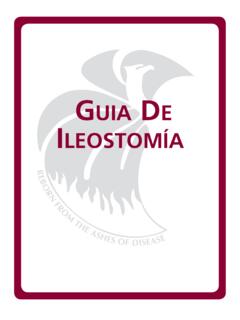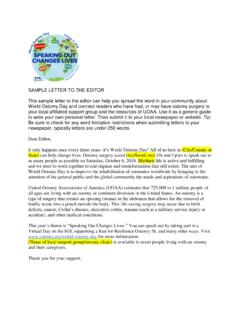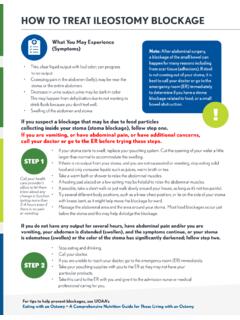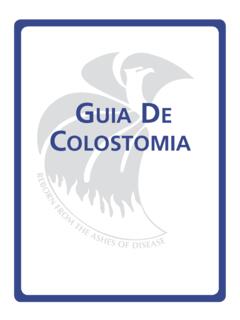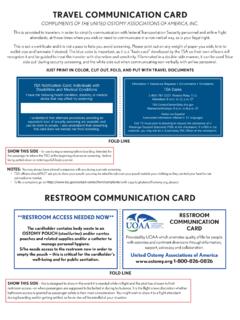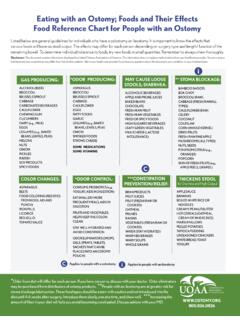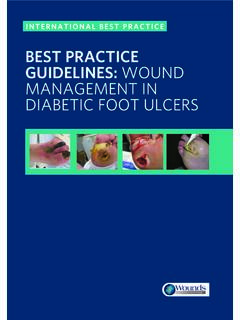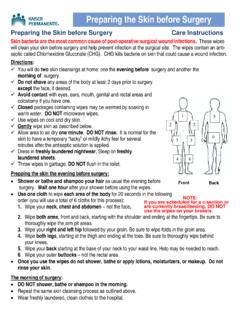Transcription of Basic Ostomy Skin Care
1 Basic Ostomy SKIN CARE A GUIDE FOR PATIENTS AND HEALTHCARE PROVIDERS wound , Ostomy , Continence Nurses SocietyTM (WOCN ) 2 Contents Acknowledgments .. 3 Introduction .. 4 The best approach is to keep pouching simple .. 4 Caring for Yourself .. 5 How do I choose a pouching system? .. 5 What kind of skin barrier is best? .. 5 How often should I change my pouching system? .. 5 When is a good time to change my pouching system? .. 6 How do I take off the pouching system? .. 6 How do I clean around my stoma? .. 6 What should I do with my soiled supplies after I change my pouching system? .. 7 Can I get my pouching system wet? .. 7 What are some ways to keep my skin from getting irritated?
2 8 Will the pouching system irritate my skin? .. 8 How can I prevent infection? .. 8 Is it okay to patch the pouching system if there is a leak? .. 8 How can I prevent leakage? .. 9 How can I get the pouching system to stick better if I sweat? .. 9 How do I remove hair from around my stoma? .. 9 Ostomy Care Products .. 9 Should I use a skin sealant? .. 9 Should I use extra tape or elastic barrier strips to hold my pouch on? .. 9 Should I use adhesive remover? .. 9 Do I need to use a skin barrier product (tube paste, strip paste, powder or rings)? .. 10 What are Ostomy adhesive products? .. 10 When do I need to use an Ostomy skin barrier powder?
3 10 Glossary .. 11 References .. 12 wound , Ostomy , Continence Nurses SocietyTM (WOCN ) 3 Acknowledgments Basic Ostomy Skin Care: A Guide for Patients and Health Care Providers Originated By: wound , Ostomy and Continence Nurses Society s (WOCN) Clinical Practice Ostomy Subcommittee in 2007 and updated in 2012. Updated/Revised: From January 2018 October 2018 Contributing Authors: Mary F. Mahoney, MSN, RN, CWON, CFCN wound and Ostomy Nurse UnityPoint at Home Des Moines, Iowa Barbara J. Rozenboom, BSN, RN, CWON wound Ostomy Nurse UnityPoint at Home Des Moines, Iowa wound , Ostomy , Continence Nurses SocietyTM (WOCN ) 4 Introduction People who have a stoma often have many of the same questions and concerns.
4 This resource document gives answers to some of the questions that people ask about the care of a stoma and the skin around the stoma. The answers are for the person who has a stoma but may be helpful for the nurse as a teaching tool. People with a stoma may think it is normal that the skin around their stoma could get sore from the stool, urine, or the pouching system. The skin around the stoma should look the same as the rest of the skin on the It is important to protect the skin from stool, urine, and chemicals by treating the skin gently and using products correctly. This will decrease the chance for skin problems. The best approach is to keep pouching simple.
5 The best approach to pouching is to start with a Basic pouching system. Extra products should only be added when needed to get consistent wear time and to keep the skin It is important to follow your wound , Ostomy , continence (WOC) nurse or health care provider s recommendations and to follow the directions from the product manufacturers. If you have questions about the information in this document, problems with leakage, or skin problems around the stoma, contact your WOC nurse or your health care provider. wound , Ostomy , Continence Nurses SocietyTM (WOCN ) 5 Caring for Yourself How do I choose a pouching system? Pouching system means the products used to collect stool or urine.
6 The skin barrier includes a sticky backing that adheres to the skin and a pouch that holds the urine or stool. This system should provide a secure seal and protect the skin around the There are three Basic types of ostomies. o Urostomies are for drainage of urine. o Colostomies are for drainage of stool from the large bowel. o Ileostomies are for drainage of stool from the small What kind of skin barrier is best? The best barrier is a solid skin barrier that creates the seal and protects the skin around the stoma. There are several unique ingredients in the skin barrier. The sticky backing of your pouching system is made of different types of materials.
7 Your WOC nurse or health care provider will tell you which sticky backing is best for A standard wear barrier is used for semi-formed or formed stool. An extended wear barrier is used for urine or stool that is loose or liquid. The extended wear barrier does not break down like a standard wear barrier when it comes in contact with loose or liquid Some types of barriers may have added ingredients that can be used when the skin around the stoma is When choosing an Ostomy pouching system, consider which products your insurance How often should I change my pouching system? The type of pouching system you wear and how often you will need to change your pouching system depends on: o The type of stoma o The location of the stoma o The drainage from the stoma4 Using the right type of pouching system and putting it on right will also affect how long you can wear it.
8 Wear time may be affected by other factors such as: o Activity level o Body shape o Perspiration3 The length of time you are able to wear a pouching system depends on you and the type of stoma you have. Some people may be able to leave a system in place for 3-7 days. Some systems are made to be changed Your pouching system should be changed as soon as possible when leakage is noted or if your skin is sore or Contact your WOC nurse or health care provider if: o You are changing your pouching system more often than expected o You are suddenly changing more often than your normal wear time o Your skin is red or wound , Ostomy , Continence Nurses SocietyTM (WOCN ) 6 When is a good time to change my pouching system?
9 The best time to change the pouching system is different for everyone. Choose a day and time that works best for you. Try to choose a time when your stoma is not producing a lot of urine or stool. For most people, the stoma is less active before eating or drinking in the morning. Some people will change their pouching system after they take their bath or shower. Other people may choose to do their change at the end of the day or at least two hours after a How do I take off the pouching system? Take your time when you remove your pouching system. Take it off gently and in the direction the hair grows. Taking off your pouching system too fast may cause damage to your ,6 As you take off the pouching system, loosen and lift the edge with one hand and press down on the skin near the sticky backing with the other hand.
10 You may find it helpful to start at the top and work down to the bottom so you can see what you are doing. This will also allow the pouch to catch any urine or stool the stoma ,6 If needed, you may use warm water or adhesive remover to remove the pouching system. If you use adhesive remover it is very important to wash off all of the adhesive remover from your skin with non-oily soap and water. Then, dry the skin completely before you put on your new pouching Your skin may look more pink, red or darker than your normal skin color right after you take off your pouching system. This color should fade away within a few minutes after removing the pouching How do I clean around my stoma?
